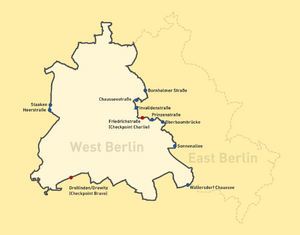| The following Die Mauer Steht article is under construction.
Please do not edit or alter this article in any way while this template is active. All unauthorized edits may be reverted on the admin's discretion. Propose any changes to the talk page. |
The Berlin Wall (German: Berliner Mauer) is a physical and technological barrier surrounding West Berlin, physically and separating the city from the German Democratic Republic (DDR, or East Germany). It was first constructed in 1961, and has seen progressively more sophisticated barriers and deterrents built in the decades since.
Background[]
On June 15th, 1961, DDR leader Walter Ulbricht was asked a question by a West German journalist regarding the possibility of a border construction. The English translation of the question and answer is as follows:
Journalist: "Mr. Chairman, do you believe that creating a free city will require the construction of a state border at the Brandenburg Gate, and are you determined to see this through, with all the consequences it entails?"
Ulbricht: "I understand your question in this way - that there are people in West Germany who want us to mobilize the construction workers of the GDR capital to build a wall, am I right? I'm not aware of any such plans. Most of the capital's construction workers are busy building flats, and their manpower is being put to full use in these projects. Nobody has any intention of building a wall."
Construction[]
In. the middle of the night between the 12th and 13th of August, 1961, the Volkspolizei, Operation Combat Groups (Betriebskampfgruppen), and the Nationale Volksarmee (NVA) encircled West Berlin with barbed wire and stone walls. The DDR named it the "antifaschistischer Schutzwall", or anti-fascist protective rampart.
Early Layout and Designs[]
In June 1962, a second, parallel fence was built 100 meters farther into DDR territory. The houses contained between the fences were razed and the inhabitants relocated, establishing what would become known as the "Todesstreifen", or death strip.
In 1975, new concrete segments, which were more resistant to breakthroughs and to environmental pollution, were erected, in a project called "Grenzmauer 75" (Border Wall 75).
These improvements included slick, rounded tops to the segments, to make it harder for refugees to scale.
Refugees[]
In the first early days of the Wall's construction, refugees from East Berlin jumped, burrowed, climbed, and swam their way through gaps in the barrier. Over time, the weak points in the Wall were found and blocked. Those who attempted to escape in later years were met with armed guards, watchtowers, hounds, and other deterrents.
As of 2017, over 2,300 people have been killed attempting to cross the border.
Incident of 1989[]
Following popular protests against the government, the SED Politburo voted to remove Erich Honecker on October 18th, 1989. Egon Krenz, a member of was elected as the new General Secretary of the SED Central Committee.
In his inaugural speech to the Central Committee, Krenz emphasized that the face of the Central Committee was turned towards the people. For the first time, for example, Krenz allowed filming in the Politibüro building.
As part of stated reforms, Krenz and SED found itself compelled to make concessions, such as the freedom of travel. Increasing numbers of refugees from East Germany were were finding their way to Hungary via Czechoslovakia. To ease the difficulties between the GDR and Czechoslovakia, Krenz decided on to allow refugees to exit directly through crossing points on the Inner German Border, including between East and West Berlin at the Berlin Wall.
Günter Schabowski, spokesman for the Politbüro, had the task of announcing the new regulations. However, he had not been involved in the discussions about the new regulations and had not been fully updated. When asked by journalists when the borders would be opened, he replied "Ab sofort" - or "without delay."
However, Erich Mielke, the longtime head of the Ministry for State Security (Stasi) had taken part in the Politibüro discussions. When the crowds of refugees gathered at the border, Mielke gave the Stasi authority to prevent them from crossing until the appointed time, by force if necessary. At midnight, Stasi and some Volksarmee members opened fire on the crowds, killing over 60 in minutes. Over the course of the night, over 200 people were killed, with nearly 1000 more injured.
High-Tech-Mauer-2000[]
The Fifth Generation of the Wall's construction was first planned in 1989, to implement the addition of microwave sensors and cameras, anticipating to bring the Wall into the 21st Century. Construction of this phase began earlier than anticipated, after the Incident of 1989, and was completed in 1995.
Die Aktualisierung[]
In 2014, the government of Sahra Wagenknecht pushed for die Aktualisierung (the Update) to the Wall, including more advanced digital sensors and the implementation of drones to monitor the death strip.



